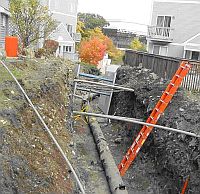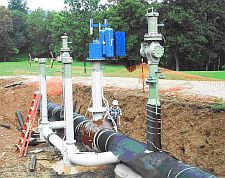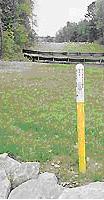What Do Transmission Pipelines Look Like?
 Transmission lines are buried. The only above ground facilities are markers that identify the approximate location of the pipe, city gate and compressor stations and valve sites.
Transmission lines are buried. The only above ground facilities are markers that identify the approximate location of the pipe, city gate and compressor stations and valve sites.
Transmission lines in Connecticut are found in rural areas, as well as in congested areas.
When first constructed in Connecticut, most transmission lines traversed open areas away from population centers. Since then, homes and business have been built near the transmission lines.
 This valve site is under construction. The mainline valve allows the gas flow to be stopped, either for maintenance or in an emergency. Special piping allows the main line valve to be by-passed. Blow-offs allow the pressure to be safely lowered to empty the segment and reduce the pressure to zero.
This valve site is under construction. The mainline valve allows the gas flow to be stopped, either for maintenance or in an emergency. Special piping allows the main line valve to be by-passed. Blow-offs allow the pressure to be safely lowered to empty the segment and reduce the pressure to zero. After the construction is completed, the mainline, valve and bypass will be buried and only the control facilities and blow off vents will be above ground. (Note the existing surface level to which the backfill will reach.) The entire above ground facility will be surrounded by a chain link fence with locked gates.
After the construction is completed, the mainline, valve and bypass will be buried and only the control facilities and blow off vents will be above ground. (Note the existing surface level to which the backfill will reach.) The entire above ground facility will be surrounded by a chain link fence with locked gates.
Transmission lines have above ground markers to warn excavators and the public of the presence of the buried gas lines.
Gas Pipeline Safety
Content last updated April 2025
Content last updated April 2025

